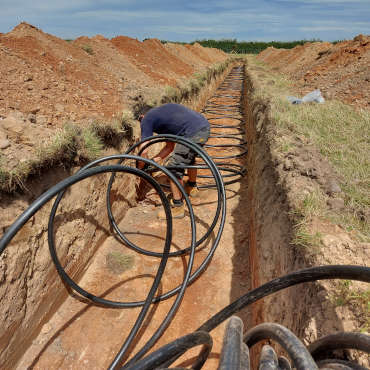District heating offers the promise of a simple solution for the supply of low carbon heat to homes, businesses and public buildings across the UK. It’s all about taking energy released as heat from a range of energy sources and connecting to energy consumers through a system of highly insulated pipes.
Heat networks can vary enormously in size, which means that cheaper, lower carbon sources of heat generation can be added over time without additional, later upheaval such as digging up roads, or making changes in people’s homes.
District heating vs community heating
Community heating is about supplying heat to a relatively small development of one or perhaps two buildings with multiple dwellings, such as a multi storey block or sheltered housing complex.
District heating has wider objectives: distributing large-scale sources of heat over a large area and connecting multiple buildings in a heat network. Both community and district heating can be described as heat networks.
How community heating is different to a traditional heating system
Most customers will hardly notice the difference between a home that’s heated with an individual gas boiler and one that’s heated by community heating. There are, however, some important differences:
- You have immediately available, unlimited hot water supply.
- You pay for the useful heat supply, rather than the amount of gas consumed.
- There’s reduced maintenance for the individual heating system, as there is no boiler to safety check and maintain.
- The HIU that takes the place of the boiler is smaller than a traditional wall-hung boiler, giving you more space.
- There’s no hot water storage cylinder.
- Homes use electricity for cooking, as there is no gas supply.
- There’s only one heat supplier.
- Heat networks work by distributing energy that is generated in a central location by a larger boiler to individual homes through a series of insulated pipes.
Sources of heat input
There have been changes in the type of technology. Applications were initially dominated by wood fuel-based systems but schemes based on heat pumps (ground, water, and air source) are on the rise, Various possible technologies could provide the input to a heat network including power stations, energy from waste (EfW) facilities, industrial processes, biomass and biogas fuelled boilers and Combined Heat and Power (CHP) plants, gas-fired CHP units, fuel cells, heat pumps, geothermal sources, electric boilers and solar thermal arrays.
Applications in practice
There is considerable support for the expansion of such heating networks. While just over 2% of UK homes are currently connected to a district heating network, more are expected to come online as the UK transitions to net zero over the coming decades. There are already over 17,000 heat networks in place in the UK, and nearly half a million connections to them, most of which are domestic customers. They are a particularly attractive option in dense urban areas and have been cited as a way of tackling fuel poverty while also reducing housing management costs.
In Scotland, the District Heating Loan Fund, funded by the Scottish Government, is working to support good quality schemes that reduce bills, reduce emissions and create jobs. In England and Wales, the UK Government launched a £320 million investment programme in 2018, as part of ambitious plans to extend district heating capacity, driven by local authorities. There is a target in place for 15-18% of heat to be generated from networks of this kind by 2050.
There is, though, a long way to go before the UK is anywhere near levels of uptake elsewhere in Europe. For example, the city of Copenhagen is almost entirely served by district heating, and around 65% of housing in Denmark as a whole, with not-for-profit organisations and consumer owned cooperatives heavily involved in supply. By way of comparison, there is just over 2% uptake of district heating in the UK at present with very few not-for-profit agencies delivering heat.
Relevance for community groups
For community groups thinking that district heating might be for them, it’s important to consider that a certain degree of expertise is required to build out and manage schemes. It’s a big ongoing commitment, requiring responsibility for heating, metering and billing – to all intents and purposes becoming a small utility company.
Community heating systems are more environmentally-friendly than individual boiler-powered heating systems
- They’re efficient, reprocessing heat waste and delivering energy with minimal wastage
- Can be deployed where the only alternative would be electrical heating
- Individual billing via modern meters provides detailed information about energy usage
- Community heating can cut costs to the housing management and to the consumer
- Consumers can choose to pay as they go on a property-by-property basis
- Long-term financial support program available for renewable heat
It’s clear, too, that there needs to be more advice for households looking to either connect to or disconnect from schemes. For those considering getting involved, there’s a lot to think about. Research is required, and it’s important to seek independent legal advice before signing any heat sales contract with a supplier. In Scotland, householders can contact Home Energy Scotland for advice if they are thinking of connecting to a district heating scheme.
Links
https://energysavingtrust.org.uk/what-district-heating/
https://switch2.co.uk/resources/guide-to-community-heating/
https://energetik.london/how-it-works/community-heat-networks/
https://www.housing.org.uk/resources/energy-crisis-fuel-poverty-communal-district-heating-systems/
https://communityenergyengland.org/
https://www.buildwithrise.com/stories/costs-and-benefits-of-ground-source-heat-pumps
https://energysavingtrust.org.uk/air-source-heat-pumps-vs-ground-source-heat-pumps/


